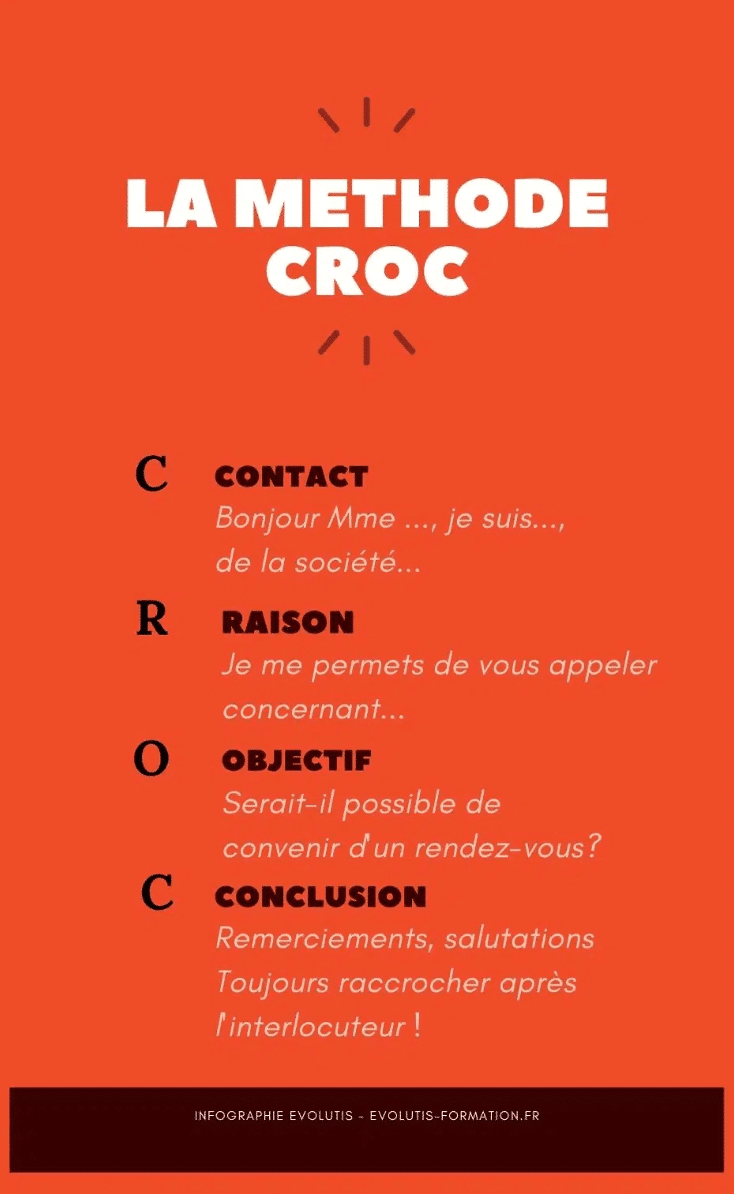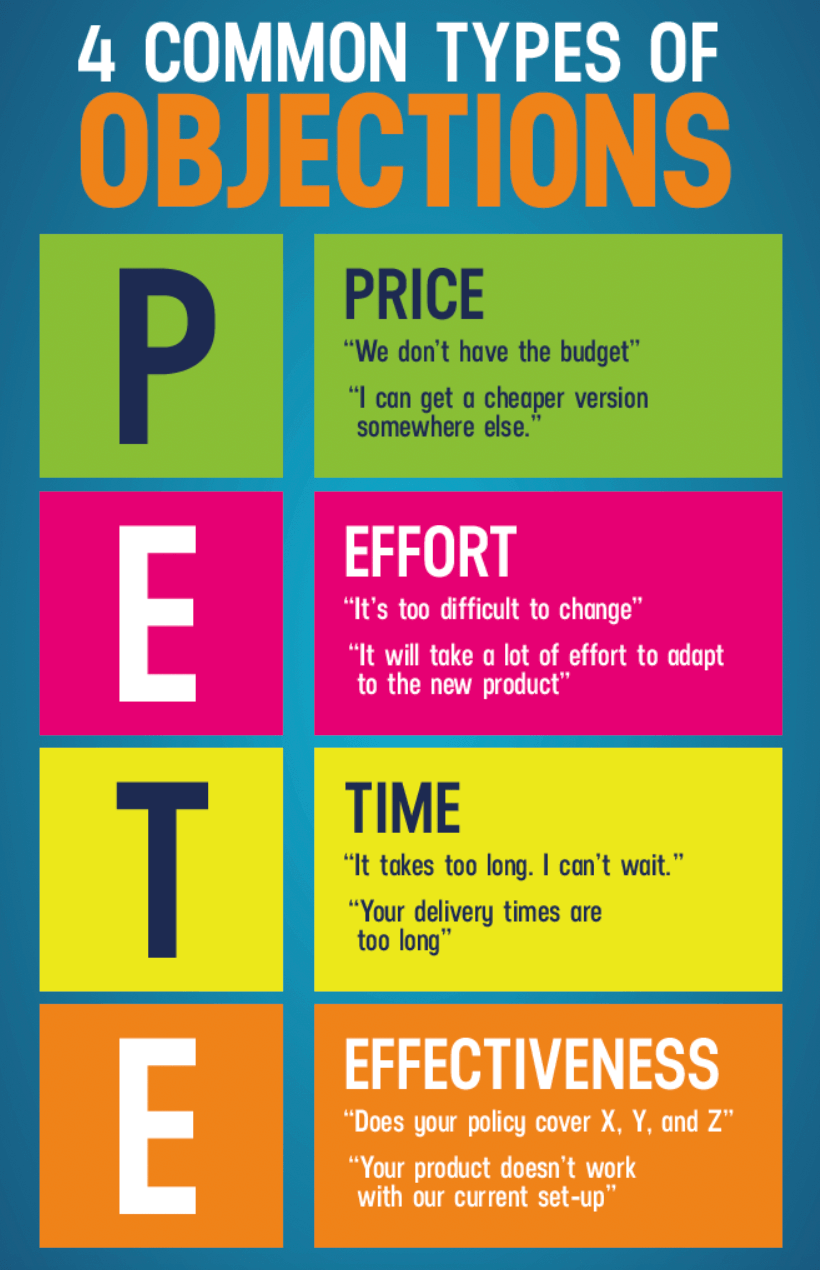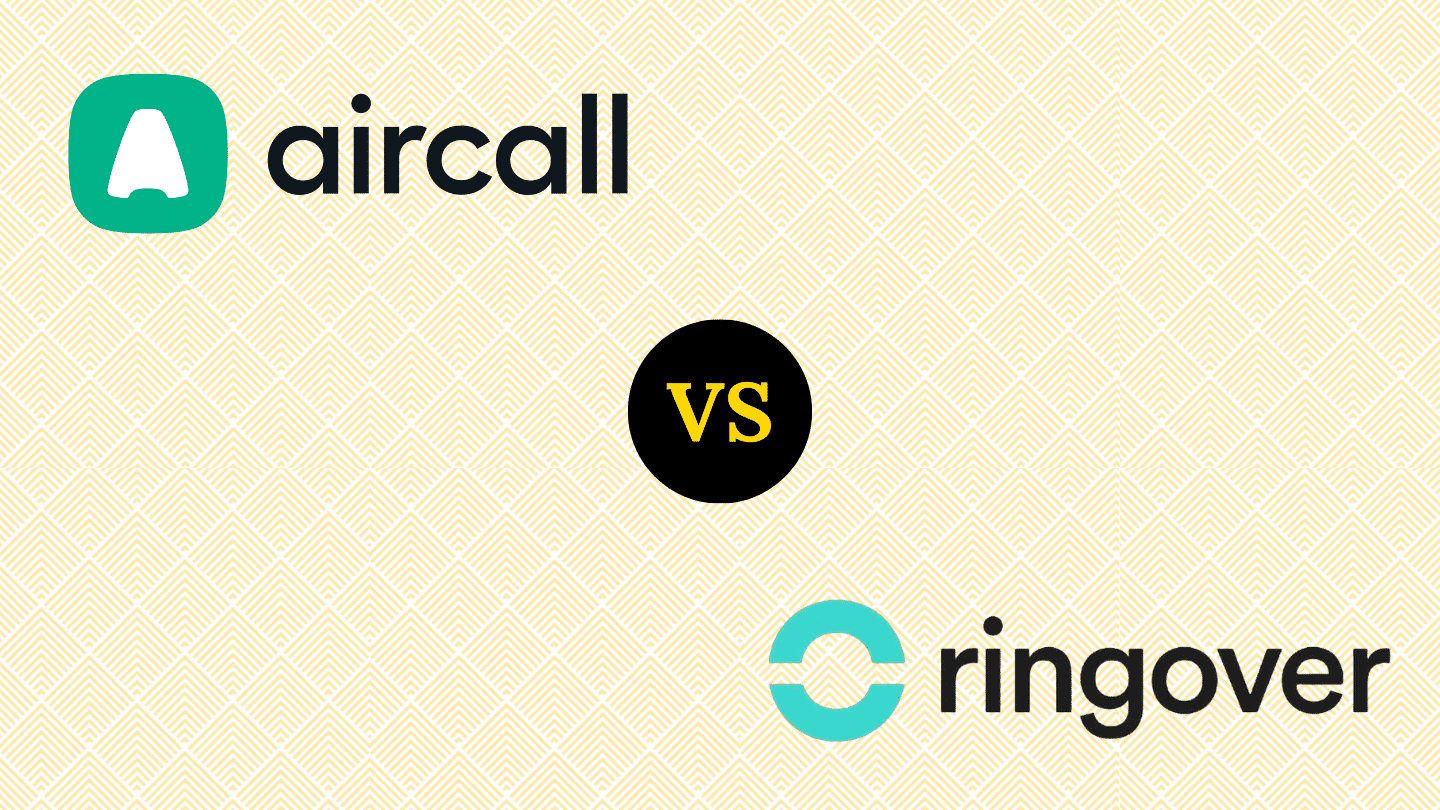Do you run a start-up or a small SME and are looking to boost your telephone prospecting?
You’ve come to the right place.
In the world of B2B sales, picking up the phone is still one of the most effective ways of generating qualified leads.
But you still need to know how to do it…
That’s where the CROC method comes in.
No, we’re not talking about plastic shoes, but a formidable technique for structuring your prospecting calls.
In this article, we’ll explain how to use it to turn your cold calls into real appointment machines.
Sommaire
The CROC method explained
What is the CROC method?
The CROC method (Contact, Reason for Call, Objective, Conclusion) is a sales strategy designed for telephone prospecting.
It breaks down into 4 key stages:
- Contact: Establish initial contact.
- Reason: Explain the reason for your call.
- Objective: Present the objective of your approach.
- Conclusion: Conclude the call with a clear action.

Contact : Breaking the ice
The contact is your introduction.
There’s no need to get fancy, just be direct and professional: “Hello, I’m Thomas from Salesdorado. Am I speaking to Julie Dupont, Marketing Manager at TechStartup?”
The objective here?
Make sure you’re talking to the right person, and lay the foundations for a professional conversation.
Reason: Giving meaning to your call
Now that you’ve made contact, quickly explain why you’re calling.
You need to be both concise and punchy: “I’m contacting you because we help companies like yours optimize their sales process with our CRM software.”
Don’t waste your time talking, get straight to the point.
Your prospect has other things to do than listen to an interminable monologue.
Objective: Demonstrate the value of your proposal
The next step is to highlight the added value of your product or service.
Focus on the benefits for your prospect: “Our aim is to help you increase your conversions by 30% by automating your time-consuming tasks. This would allow you to focus on what really matters: the customer relationship.”
Be specific and quantify your promises, wherever possible of course.
Companies love concrete results.
Conclusion: Taking action
You should never let your call end on a sour note.
At the end of the call, always remember to propose a concrete action: “To show you in concrete terms how it works, how about a 15-minute call on Thursday at 2pm for a quick demo?”
Salesdorado tip Be proactive and propose a specific date and time.
It’s more effective than vaguely asking “when will you be available?”.
Why does the CROC method work?
The CROC method is a tried and tested telephone prospecting technique – and continues to be so – for a number of reasons.
First of all, it’s a method that shines for its simplicity.
It’s easy to memorize and apply, even for budding salespeople.
This makes it easy for teams to adopt.
The CROC method follows a logical structure that gets straight to the point.
Using the CROC method is the best way to avoid falling into the trap of unnecessary digressions.
The sequential approach – Contact, Reason, Objective, Conclusion – enables the salesperson to maintain control while addressing all the essential points.
Linked to the previous point, the CROC method respects the precious time of your prospects and sales reps.
It saves everyone’s time.
The effectiveness of the CROC method also lies in the last “C” of the acronym: the conclusion.
It’s not only a structured approach, but also, and above all, one that’s focused on a clear goal: the call to action.
The CROC method guides the conversation towards concrete action.
In short, the CROC method’s simplicity, structure, effectiveness and results orientation make it a powerful framework for productive prospecting calls.
For all these reasons, it would be wrong not to give it a try.
But how do you go about it?
That’s the subject of the next section.
How to build a call plan with the CROC method?
Now that you’ve understood the basics of the CROC method, let’s get down to the nitty-gritty.
How do you build an effective calling plan based on the CROC method?
Here are the main steps:
#1 Do your homework
Before you even pick up the phone, you need to be prepared.
Every prospecting call, every cold call, requires preparation.
No, we’re not talking about doing 50 push-ups, but rather :
- Google your prospect and his company (it takes 2 minutes, no excuses).
- Check their LinkedIn profile in detail (to find out more: discover how to prospect on LinkedIn)
- Identify the main business challenges of your prospecting.
This preparation will enable you to personalize your approach.
A salesperson who knows his target is like a sniper: he never misses (or, at least, he’s less likely to miss).
#2 Define your goal
What do you want to get out of this call?
An appointment?
A demo?
A direct sale?
You need to be very clear about the objective of the call.
You also need to be realistic.
If you’re selling €10K/year software, don’t expect to close the sale in a single call.
Instead, aim for a qualifying appointment or a demo.
#3 Prepare your CROC pitch
You know your prospect and the objectives of the call – your objectives.
Now you can get down to business.
For each step of the CROC method, prepare a mini sales script, 3-4 key phrases:
- Contact: Your introductory sentence.
- Reason: Why you’re calling (the sentence must be powerful).
- Objective: The value you bring (with supporting figures if possible).
- Conclusion: Your call-to-action.
Write these sentences down, but don’t memorize them.
The aim is to sound natural, not robotic.
#4 Anticipate objections
You know the drill: “It’s not the right time”, “We’ve already got a solution”, “It’s too expensive”… 95% of objections can be anticipated and prepared.
For each classic objection, prepare 2 or 3 responses.
#5 Create your call record
Put all this information together in a simple call sheet.
This can be a Word doc, a GDoc, a Trello, or even a post-it note (if you have small handwriting).
The important thing is that it’s easily accessible during the call.
Here’s what your call sheet might look like:
Sample callsheetProspect: Julie Dupont, CMO at TechStartup.
Key info: Recent Series A, in rapid scaling phase. CROC:
- C: “Hello Julie, Thomas de Salesdorado…”
- A: “I’m contacting you because we help hyper-growth startups like yours to…”
- O : “Our aim is to save you 5 hours a week on your repetitive marketing tasks…”
- C: “How about a 20min call on Thursday at 2pm to show you how?”
Objections:
- No time: “I understand, that’s precisely why…”
- Already a solution: “Great, what do you like best about your current solution?”
#6 Test and iterate
Rome wasn’t built in a day, and neither was your perfect call plan.
After each round of calls, take 5 minutes to note what worked and what can be improved.
Don’t hesitate to try out different approaches.
As long as you stay within the CROC framework, you can play around with words, tone, order of info…Find what works best for you and your target.
Going further To make sure you get as many responses as possible, here we reveal the best times for your prospecting calls.
#7 Build your team
If you have a sales team, even a small one, share your calling plan with them.
Organize role-play sessions to get everyone comfortable with the CROC method.
Remember: a calling plan is like a fine wine, it improves with time (and practice).
5 concrete examples of call plans using the CROC method
Enough theory, let’s get down to business!
Here are 5 examples of calling plans that will show you how the CROC method can be applied in different situations.
Take notes, get inspired, and adapt these examples to your own needs.
#1 First contact with a cold prospect
Context: You’re selling project management software and you call the product manager of a fast-growing startup. C Hello, I’m Sarah from ProjectPro. Am I speaking to Thomas, the product manager at TechInnovate?” R “I’m contacting you because we help startups like yours deliver their projects 30% faster thanks to our project management tool.” O “Our aim is to save you time on team coordination so you can concentrate on product innovation.” C “Would you be interested in a 15-minute call on Thursday at 2pm to see how this could be applied to your team?”
#2 Follow-up a prospect after an email
Context: You sent an email last week about your marketing automation solution.
No response, so you call back.
C: “Hi Julie, it’s Marc from AutoMark. I hope I’m not disturbing you?”
A: “I’m calling further to the email I sent you last week regarding our marketing automation solution.” O: “I wanted to make sure you’d received it and see if you’d be interested in doubling your email open rates by automating your campaigns.” C: “How about a quick 20-minute demo next Tuesday to see how it works in practice?”
#3 Qualification call
Context: A prospect has filled in a form on your website to find out more about your online accounting service.
You call to qualify the lead. C Hello, this is Léa from ComptaSimple. Am I speaking to Alexandre? Was it you who asked us about our service yesterday?” R “I’ll call you to discuss your request and see how we can help you with your accounting.” O “My aim is to understand your specific needs to see if our solution, which typically saves 5 hours a week on accounting tasks, would be right for you.” C “Would you have 10 minutes now to tell me about your current accounting challenges?”
#4 Make an appointment for a demonstration
Context: You’re selling a specialized CRM for real estate agencies and you’ve already had a positive first contact with the prospect. C Hello Sophie, this is Julien from ImmoCRM. How have you been since we last spoke?” R “I’ll call you back as agreed to arrange a demonstration of our CRM, which, let me remind you, helps agencies like yours increase their sales by an average of 25%.” O “The aim of this demo is to show you in concrete terms how our tool can adapt to your sales process and automate your customer follow-ups.” C “I have two slots available next week: Tuesday at 10am or Thursday at 2pm. Which would you prefer?”
#5 Managing a current objection
Context: You’re selling a cybersecurity solution and your prospect tells you he doesn’t have the budget.
C: “I completely understand, Thomas. Budget is always an important consideration.”
A: “That’s precisely why I’m calling you. Many of our customers had the same concern before realizing the savings our solution can generate.”
O: “Our aim is not to be an additional cost, but to save you money. On average, our customers save €30,000 a year by preventing attacks and optimizing their IT infrastructure.”
C: “What would you say if I sent you a detailed case study showing the return on investment for a company similar to yours? We could then discuss it in a 15-minute call next week.”
There you have it, 5 concrete examples of how to apply the CROC method in different situations.
Of course, you don’t have to copy and paste them.
The idea is to draw inspiration from them and adapt them to your style, your product and your prospects.
10 tips to optimize your calls with the CROC method
Now that you’ve mastered the basics of the CROC method, it’s time to step up a gear.
Here are a few tips to turn your prospecting calls into real conversion machines.
#1 Customize like a pro
The secret of a successful call?
Customization.
Forget generic scripts that reek of reheating.
Here are a few tips:
- Mention a recent company blog post.
- Refer to recent industry news.
- Quote the prospect’s LinkedIn post.
- Comment on a recent company achievement (new product, partnership, fundraising).
- Make a link to an event in which the company has recently participated.
- Mention a common customer or partner.
#2 Master the art of silence
The judicious use of silence is an underrated skill in telephone prospecting.
After asking a question, resist the temptation to immediately fill the void.
Strategic silence, even if potentially uncomfortable, can be a powerful tool for gaining valuable information.
Mentally count to five if necessary.
This pause will create a slight tension and prompt the other person to elaborate on their response or share additional information.
It’s in these moments that prospects frequently reveal important details about their needs, challenges or decision-making process.
#3 Use the power of anecdotes
Stories capture attention.
Prepare 2-3 short anecdotes about how your product has helped similar companies.
Example: “Just last week, a start-up like yours increased its conversions by 40% in just one month thanks to our tool. Their CEO couldn’t believe it!”
#4 Ask the right questions
The right questions do 80% of the work.
Forget closed questions like “Are you satisfied with your current solution?”.
Instead:
- “What frustrates you most about your current process?”
- “If you had a magic wand, what would you change about the way you handle leads?”
- “How do you see your [votre domaine] needs evolving over the next 6 months?”
#5 Control your tone of voice
Your voice is your instrument.
Play it!
A few tips:
- Smile as you talk (you can hear it)
- Vary the pace (slowing down on important points)
- Adapt to your interlocutor’s tone of voice (if he’s fast, be dynamic).
#6 Use mirroring
Mirroring is the art of subtly mirroring the language and tone of your interlocutor.
If he uses technical terms, do the same.
If he’s more relaxed, loosen your tie a little (metaphorically, of course).
#7 Handle objections
Here are some tips for dealing with objections:
- Listen carefully and always show empathy.
- Validate the prospect’s concerns.
- Ask questions to help you understand the context.
- Share real-life examples of customers who have had similar concerns.
- Propose solutions tailored to the prospect’s specific situation.

#8 Conclude with flair
Never let a call end without concrete action.
Once again, this is the basis of the CROC method: it’s oriented towards a precise end, action.
If you don’t get the appointment, at least offer to send information by e-mail.
And always set the next point of contact.
#9 Debrief and iterate
After each call, take 2 minutes to note what went well and what can be improved.
There are no secrets: that’s how you make progress!
#10 Practice, practice, practice
The CROC method is like riding a bike.
In the beginning, you struggle, you fall, you get up again.
But with practice, it becomes natural.
Role-play with your colleagues, record yourself, listen to yourself.
It’s embarrassing at first, but it pays off.
Salesdorado tip Remember: authenticity is the key.
The CROC method is a guide, not a straitjacket.
Adapt it, play with it, make it your own.
Conclusion
Now you’ve got everything you need to become an ace cold caller with the CROC method.
Now it’s up to you.
Theory is all very well, but nothing beats practice.
Start by testing the CROC method on 10 calls.
Note what works, what doesn’t work.
Adjust.
Try again.
That’s how you make progress.
Remember: every “no” brings you closer to a “yes”.
Every call is an opportunity to learn and improve.
And if you have any questions, feedback or just want to share your successes, don’t hesitate to let us know in the comments.
We love that at Salesdorado!






